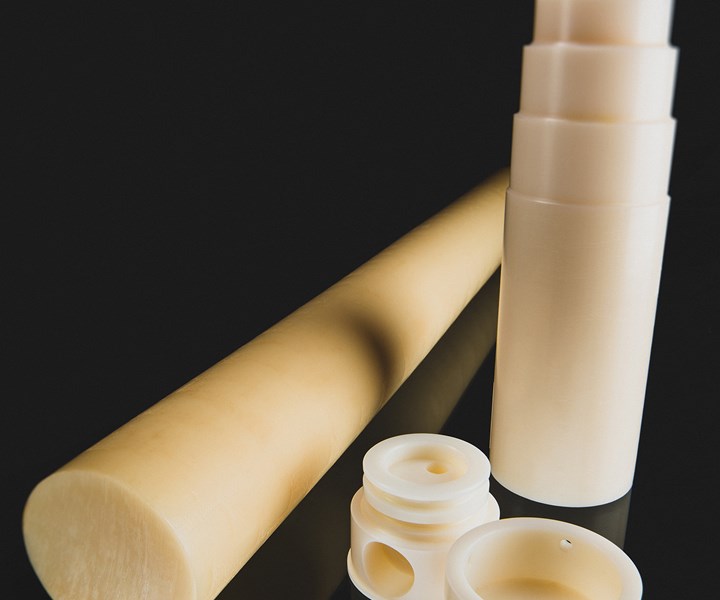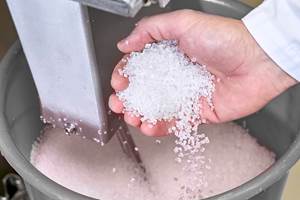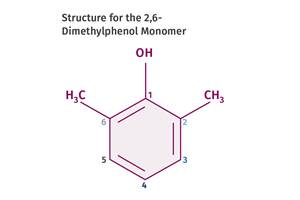Materials: Advanced PPA Meets Extrusion Processing Demands
BASF’s Ultramid Advanced N5H UN PPA boasts easy extrusion and is newly featured on what’s likely the first semi-finished PPA part.
A high-temperature resistance PPA that can be easily manufactured into semi-finished parts by extrusion in newly available fromBASF Corp., Florham Park, N.J. According to the company, commercial PPAs have been difficult to extrude for several reasons including the need for the right melt viscosity and melt temperature for processing to achieve a stable production. Said a BASF spokesman, “The material has to withstand the needed residence time. Said a BASF spokesperson. “During cooling down, no voids should show up inside the cooled semi-finished part. We developed our new PPA material to meet all these processing demands.”
New Ultramid Advanced N5H UN PPA was recently used in what may well be the first semi-finished part made of PPA by Germany’s GEHR, which produced extruded stock shapes with a diameter of 50 millimeters (1.96 in.). The material reportedly offers excellent mechanical properties at elevated temperatures due to its semi-aromatic chemical structure. It also shows excellent resistance to chemicals and hydrolysis, even in aggressive environments, as well as good sliding friction properties--and all this at temperatures above 100 C (212 F). Due to its low water uptake, its mechanical properties remain stable over a wide temperature range. Even in humid environments, the long-chain high-performance material shows a dimensional stability that belongs to the highest of all nylons.

This property profile is said to make Ultramid Advanced N the perfect material for extruding pre-fabricated components and small assemblies but also for many applications in the automotive industry, in mechanical engineering and in kitchen appliances. During machining, the behavior of the semi-finished products lies between a nylon and a polyoxymethylene copolymer (POM), with steady and consistent chip formation and removal. A wide range of applications can be manufactured from GEHR’s extruded rods: Components with very high operating temperatures and pump parts requiring exact dimensional stability are just as feasible as gear wheels, thermostat housings and sliding rails. In the automotive industry, the material is particularly suitable for components that come into contact with motor and transmission oils, coolants, acids, salts and de-icing fluids. Parts that require high sliding friction properties can be used even at high temperatures due to the material’s high impact resistance and very low wear rate.
Said Philipp Wenz, group head in sales of BASF’s Performance Materials division “GEHR is the first company to successfully use a PPA for extrusion. With its expertise in extrusion, GEHR has developed stock shapes that can be produced without any voids. We can't say for certain whether it’s the world’s first semi-finished part made from polyphthalamide. But, the high-performance material has definitely not yet played an important role in the market for semi-finished parts. One reason for this might be that usual polyphthalamides cannot be extruded very well.” As such Ultramid Advanced N5H is said to close a gap in the market between semi-finished parts made of polyetheretherketones (PEEK) and polyarylsulfones (PES) on the one hand and semi-finished products made from engineering plastics on the other hand. In comparison to the latter it can be used at continuous operating temperatures well above 120 C/248 F). The BASF material is also suitable for profiles other than rods.
Related Content
PBT and PET Polyester: The Difference Crystallinity Makes
To properly understand the differences in performance between PET and PBT we need to compare apples to apples—the semi-crystalline forms of each polymer.
Read MorePrices Up for All Volume Resins
First quarter was ending up with upward pricing, primarily due to higher feedstock costs and not supply/demand fundamentals.
Read MoreScaling Up Sustainable Solutions for Fiber Reinforced Composite Materials
Oak Ridge National Laboratory's Sustainable Manufacturing Technologies Group helps industrial partners tackle the sustainability challenges presented by fiber-reinforced composite materials.
Read MoreTracing the History of Polymeric Materials: Polyphenylene Oxide
Behind the scenes of the discovery of PPO.
Read MoreRead Next
Making the Circular Economy a Reality
Driven by brand owner demands and new worldwide legislation, the entire supply chain is working toward the shift to circularity, with some evidence the circular economy has already begun.
Read MoreBeyond Prototypes: 8 Ways the Plastics Industry Is Using 3D Printing
Plastics processors are finding applications for 3D printing around the plant and across the supply chain. Here are 8 examples to look for at NPE2024.
Read More





















